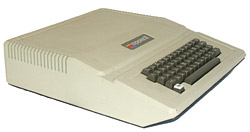The Personal Computing Revolution
Before the personal computer revolution began, computers occupied a large cabinet or even room, accepted input from punch cards, recorded data on magnetic tape, and required serious looking technicians in white coats to operate. Museum Victoria even has one such beast called CSIRAC.
Progress in miniaturisation of electronic components in the early 1970s resulted in computers getting smaller, accepting input from a keyboard and having a screen display, but they were still expensive and technically difficult to operate.
The world changed when it became possible for electronics enthusiasts to assemble components to make their own personal computer. Altair was the first to market components together in kit form, but two guys named Steve Jobs and Steve Wozniak, operating from a garage in California, were not far behind with a kit that is now known as the Apple I.
About 200 were produced, but that convinced the two Steves to found Apple Computer Inc and work on a computer that did not require electronics knowledge to assemble and use.
 It was the release of this model in 1977,
the Apple II, which heralded the widespread leap of electronics from the mainframe to personal computing.
Suddenly business, home and schools had access to computing power previously available only with mainframes.
It was the release of this model in 1977,
the Apple II, which heralded the widespread leap of electronics from the mainframe to personal computing.
Suddenly business, home and schools had access to computing power previously available only with mainframes.
The evolution of software
Early mainframe computers had to be programmed by methods which amounted to rewiring the circuits. Personal computers made the jump to programming languages—even the Apple I included Apple Basic—which evolved into "software" when lines of code were compiled into machine readable form.
 The invention of the floppy disk enabled pre-compiled software to be readily distributed instead of typed
each time from a hard copy. Soon the software industry sprang up to develop programs with an easy to use
interface to perform specific tasks, compiled onto floppy disk and distributed in shrink wrapped boxes.
The invention of the floppy disk enabled pre-compiled software to be readily distributed instead of typed
each time from a hard copy. Soon the software industry sprang up to develop programs with an easy to use
interface to perform specific tasks, compiled onto floppy disk and distributed in shrink wrapped boxes.
The Apple II had three useful software tools which we now take for granted—the word processor, the spreadsheet and the database. These were the tools that made personal computers popular.
The internet
Perhaps the most profound change has evolved from an obscure piece of hardware called the "modem" which enabled communication between computers over telephone lines. Academics in the USA (not Apple) devised protocols to facilitate communication, regardless of operating system, marking the birth of the internet.
<< back to The Apple Effect homepage
^ top of page
Five revolutions that changed your life
- Personal Computing
- Publishing
- Imaging
- Video
- Audio
 Personal
Computing Revolution podcast
Personal
Computing Revolution podcast
To download these files onto your computer, control-click (right-click) on the link and select "download linked file" (Safari) or "save link as" (Firefox). Double-click or drag the file into iTunes and it will play.
Trevor Anstey talks about how the first spreadsheet program, VisiCalc (for "Visible Calculator") which was developed for the Apple II computer, revolutionised his life:
 internet macintosh user group!
internet macintosh user group!